How to write effective feature announcement emails (+9 examples)

.png)

.png)
Whether it's a brand-new addition or a tweak to an old favorite, your feature needs the right kind of buzz. And that's where a knockout announcement email steps in. It's your chance to reengage past users, wow current ones, and even attract new fans.
Remember, there’s no one-size-fits-all here. Your feature announcement should match your product's vibe and your users' tastes. Need tips on how to make that announcement email sing? We’ve got you covered, with strategies for every type of update.
From importance level to audience targeting, we lay down the essentials of a SaaS feature launch that gets noticed. Let’s get started.
In the world of product updates, the new feature announcement is like your frontman—the one grabbing the spotlight and singing out loud about your latest and greatest. It's how you get the word out to both your die-hard fans (active customers) and those who drifted away (churned users) about the cool new stuff your product is rocking.
These changes can range from shiny new features to nifty updates on old ones. And how you announce them? Well, that's where your creativity kicks in. It could be a snappy in-app notification for a quick heads-up or a more detailed extravaganza like release notes or a blog post. Think of it as your product’s “Hey, look at me now!” moment.
Why are feature announcement emails so crucial in the grand symphony of product management? Well, think of it this way—you’ve mixed and mastered a brand-new feature—that’s awesome! But the magic doesn't stop there. The next move? Spotlighting this new hit through email campaigns that inform and entice.
These emails are more than just a shout into the void—they're strategic tools in combating churn and bolstering user onboarding. Imagine them as your product’s very own digital billboards, glowing brightly and drawing both the loyal crowd and new faces to what’s fresh and exciting in your world.
Your feature release emails play a starring role in boosting product discovery and adoption rates. They're not just announcements but an invitation to experience how your product keeps improving. These emails are your chance to show that your product isn’t just sitting idle—it's constantly evolving with new features and updates.
It’s your chance to say, “Hey, look what you’re missing out on!” Done right, these emails can turn a “see ya” into a “welcome back” by showing how your product keeps evolving to meet their needs.
And for those users who might have exited stage left a bit prematurely, a compelling feature announcement can be the encore that brings them back to the audience. But remember, the timing and tone of your announcement can make all the difference. It's about striking that perfect chord to excite your audience about your product's new developments.
Alright, so there's no one-size-fits-all recipe for cooking up a feature announcement. It's like making your grandma’s secret dish—it varies with the cook (that's you), the kitchen (your product), and even the diners (your users).
But hey, we’ve got some pro tips for you:
Feeling like you have to pull a rabbit out of a hat every time you announce a feature? Relax, we've got some steps to make it a breeze, inspired by real-world examples. And hey, if you're also planning to announce a price hike, sneak a peek at our article on that for some extra tricks.
1. Decide on the importance level of the new feature
First things first: How big of a deal is this new feature? Is it a game-changer or just a nice little addition? Rating its importance helps you figure out how to talk about it, who to tell, and how to make it shine.
2. Describe the feature
Keep it simple. What’s the feature? What does it do? How will it make life easier for your users? If you can explain it to your grandma, you’re on the right track.
3. Write an article on your knowledge center
Got all the details? Great, now spill the beans in an article. Make it rich with information, guides, tutorials—the works. This is for the folks who want to dive deep into your new feature.
4. Choose your target audience
Who needs to hear about this? If it’s something for potential new users, make it flashy and marketing-savvy. If it’s for your loyal users, cut to the chase—give them the info and benefits straight up. And don’t forget to segment your audience—not everyone needs to know about every feature.
5. Decide on your distribution channels
It’s all about being at the right place at the right time. Whether it’s in-app announcements for those already using your product, social media posts to catch new eyes, or emails for a more direct approach, make sure you’re waving your flag where it'll be seen.
Ready to roll out the red carpet for your product's latest upgrades? Let's dive into some real-life new feature announcement examples that'll spark your creativity and get your gears turning. These are the shining stars that got it right, blending information with inspiration.

For any company with a sizable following, social media can prove a terrific channel for alerting interested customers to your product’s new features. Your company’s social followers chose to follow your pages, so the odds are that they’re going to want to know more about what’s next for your product.
A new feature announcement done poorly could easily devolve into digital mayhem. (Engagement on social media is great, but not so much when it’s a Mad Max–style free-for-all.) Spotify’s Enhanced Playlist announcement, however, is a case study in highlighting proper features, including:
Predicting songs a user might like based on what Spotify knows they like is an exciting feature, and Spotify’s team does a suitable job of packaging its announcement as such. New feature announcements via social channels are an excellent way to build excitement for new features even before they roll out.
Of course, social media isn’t suitable for all kinds of feature announcements. Social posts are often awareness-based and often more appropriate for declaring “Look what you can do!” versus “Here’s exactly how to do it.” Especially since shorter post copy tends to work better on most platforms (even X, which encourages short messaging as a rule), social media isn’t the best channel for new features that require a great deal of explanation.
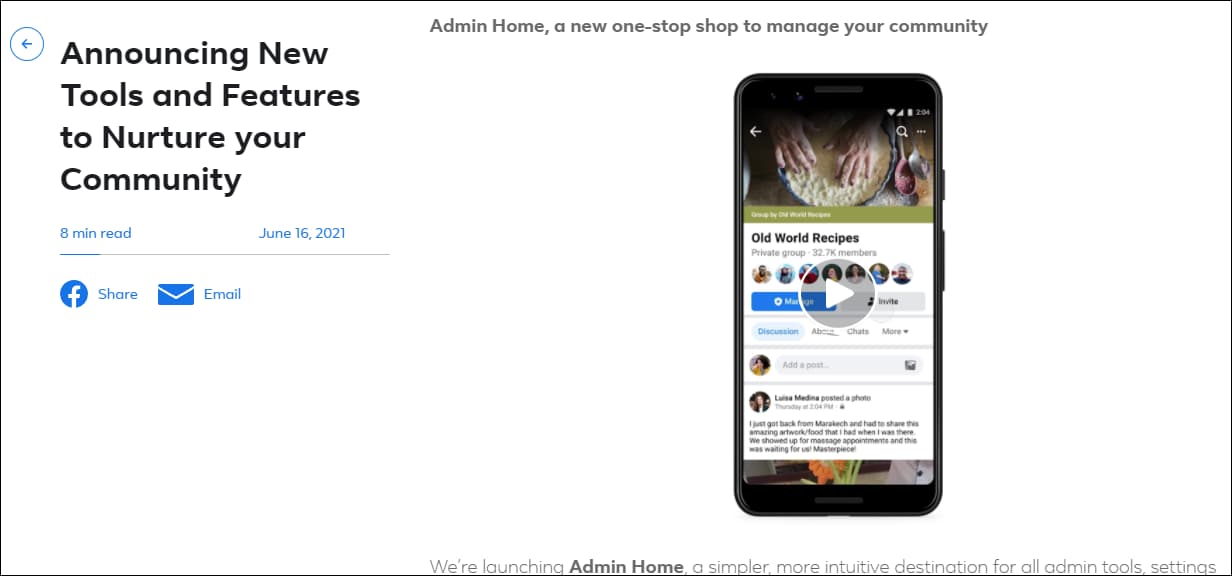
Blogs are a versatile means of conveying a great deal of information in easily consumable ways, making them a perfect choice for new feature announcements rife with instructions, details, or helpful imagery. While social media is perfect for short, awareness-based messaging, blogs enable you to dig deeper on a subject and can be as short or long as you need them to be.
Facebook dives into the features of its new community-building tools through the blog featured above. It’s an exemplary feature announcement blog that follows a number of blog-building best practices, including:
Not that Facebook would have trouble finding the resources to build… well, anything, but companies that gross less than the GDP of a small country can typically build blogs inexpensively. Most modern company websites are built with blog publishing tools as a standard feature, allowing product marketers to publish new feature announcements essentially for free. Assuming your website has blog functionality baked in, you wouldn’t need to “build out” a blog like you would a landing page, enabling you to drop your content (including helpful images) directly into pre-existing blog templates.
Blogs are similar to social posts in the sense that they can be buried in a “feed” or overarching hub page as new posts are created. Since most new feature announcements are timely, this isn’t a tragedy. However, blogs focusing on new features aren’t likely to garner overwhelming organic traffic because prospective and existing customers won’t be Googling features that, to their knowledge, don’t yet exist. Because of this, the success of new feature announcement blogs is heavily dependent upon their dissemination through other methods such as product launch emails, paid social campaigns, or broader digital advertisements.
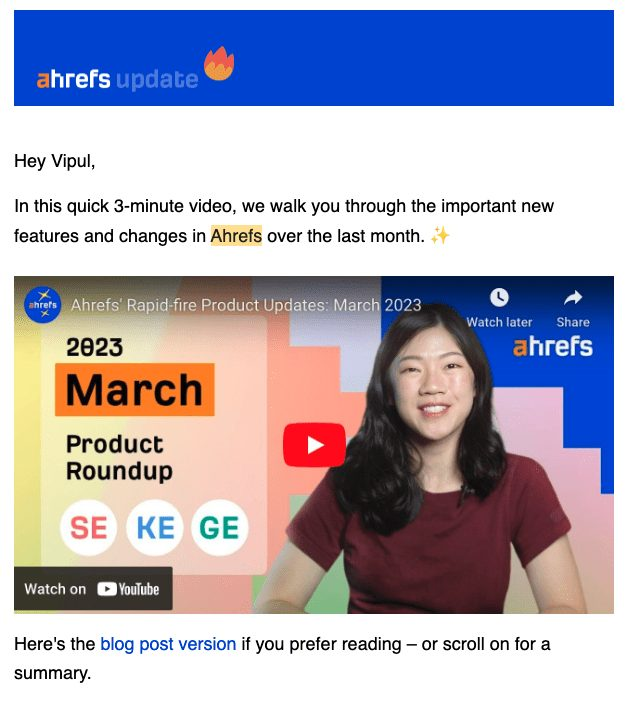
When it comes to announcing new features, Ahrefs shows a keen understanding of its audience's diverse preferences. Their May 2023 product update is a masterclass in using dual channels: a compelling YouTube video embedded right in the email for those who prefer a quick, visual overview and a detailed blog post for users who love to dive deep into the specifics.
The YouTube video is short and sweet, fitting snugly within today's shrinking attention spans. It highlights the key features with vibrant visuals and energetic narration, making the most of every second to engage and inform.
Ahrefs' clever approach here is about more than the content—it's about understanding and respecting the user's journey. They recognize that some users are ready to jump right into the video, while others might bookmark the blog for a later, leisurely read. It's this user-centric approach that makes their feature announcement not just informative but also a delightful experience.
Ahrefs also deserves a shout-out for the seamless integration of these channels into their user communication. The transition from the email to the video or blog feels natural and unforced, making the whole experience feel like a cohesive journey rather than a disjointed message. It's this kind of thoughtful design that keeps users engaged and looking forward to what Ahrefs rolls out next.
And remember, you don't need a fancy video for it to be effective. Dana Alvarenga, VP of Customer Experience at SlapFive loves embedding a screen recording in feature announcement emails to customers because it's simple and effective:
"I love to do a screen recording of how the new feature can be used and utilized put that into an email to the customers. And also schedule an office hours for 30 minutes for quality time with me and anyone technical on my team to go over this new feature and allow peers to brainstorm together on various use cases for the feature."

ClickUp understands that sometimes, the most effective message is one that speaks through familiarity and simplicity. Their announcement of the new default templates feature is a testament to this understanding. By showcasing a single, well-chosen image of the feature in use, ClickUp taps into the power of visual storytelling.
This image, a snapshot of the user interacting with the ClickUp dashboard, is instantly recognizable to existing users. It bypasses the need for lengthy explanations, instead relying on the user's familiarity with the platform. The image is complemented by minimal text, just enough to contextualize the feature without overwhelming the reader with details.
What ClickUp gets right here is the balance. The image is engaging but not overbearing, detailed but not cluttered. It invites the user to envision how the new feature will fit into their existing workflow, reducing the cognitive load and making the adoption of the new feature feel like a natural progression rather than a disruptive change.
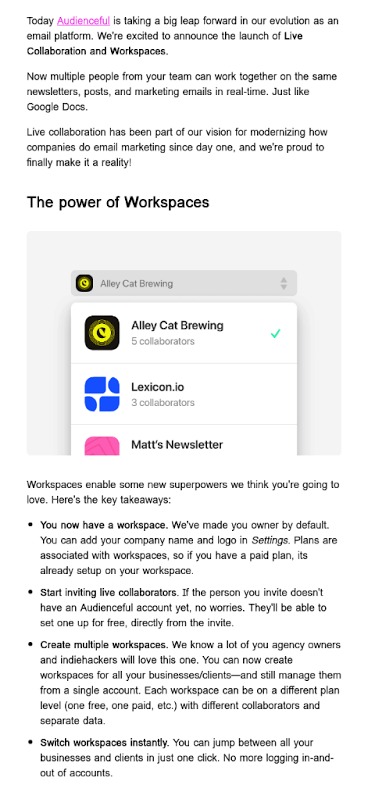
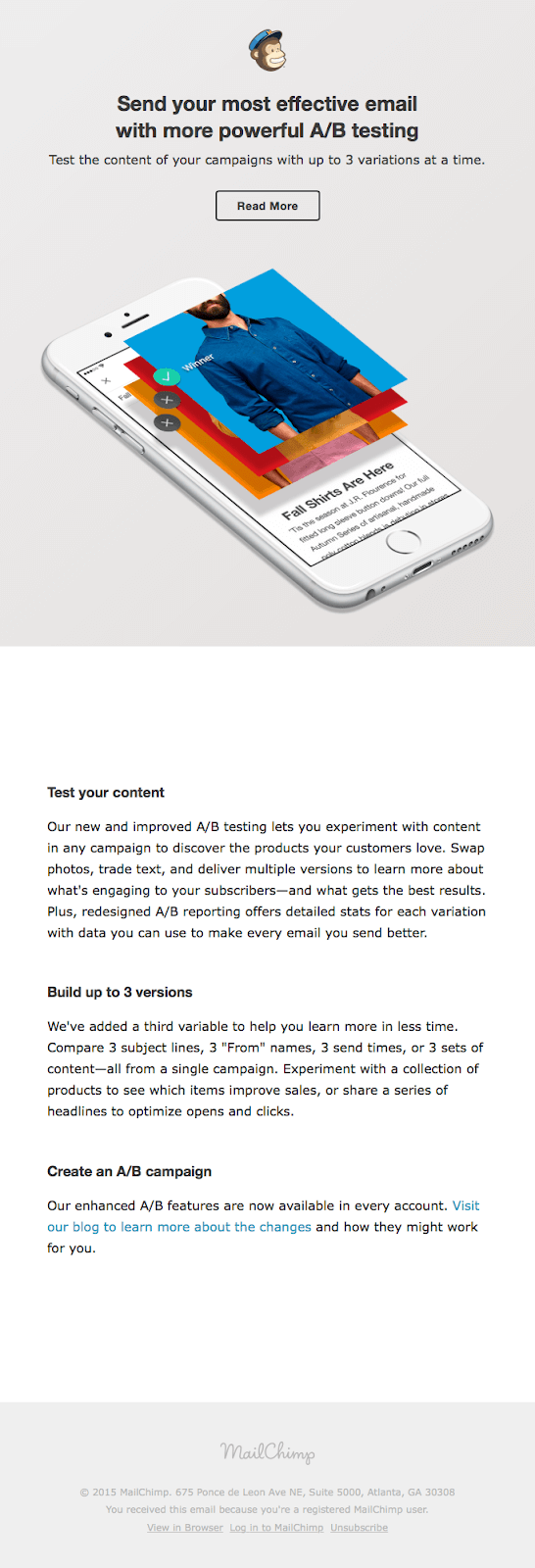
Mailchimp knows that clarity is king. Their announcement of the A/B testing feature is a prime example of their ability to communicate complex functionalities in a straightforward, user-friendly manner. The email is designed with one goal in mind: to make it crystal clear how this feature will benefit the user's marketing campaigns.
In just a few concise sentences, Mailchimp breaks down the essence of A/B testing, focusing on practical benefits rather than technical jargon. They tell users exactly what they can do with the feature and how it will impact their marketing efforts, effectively translating a technical tool into a tangible advantage.
This direct approach is refreshing in a world often cluttered with overly complex tech explanations. Mailchimp cuts through the noise, delivering a message that is easy to digest and even easier to see the value in. It's this kind of no-nonsense communication that users appreciate, especially when it comes to understanding how a new feature can make a real difference in their day-to-day work.

In some cases, landing pages can serve as a “level up” from blogs for products that continually receive new features. Whereas blogs are often built to feel personable and easily accessible, most readers want to “skim” them for the most pertinent details. Landing pages function better as resources for readers wanting exhaustive specs or technical details versus the “highlights” or deep dives on specific features often crafted for blog articles.
Microsoft takes advantage of the more cut-and-dry function of the landing page by keeping a running list of all new features for its Outlook platform on a single landing page. Microsoft uses a to-the-point design that includes:
This last bullet identifies the chief difference between landing pages and blogs: blogs can be built to appeal to both existing customers and prospective customers, while landing pages are typically designed to convert prospective customers. Microsoft’s “landing page as a list” approach saturates the page in high-quality SEO keywords pertaining to new email features. While existing customers could certainly use the landing page as a valuable resource, the clear-cut CTA conveys the page’s true purpose—to convert readers into customers.
Landing pages are capable of garnering more organic traffic than blogs when promoted to a place of prominence on your website’s navigation menu. However, landing pages still function best when part of overarching marketing campaigns such as email announcements and social or digital ads. Also, unlike blogs, these pages often need to be custom built, costing time, money, or both, which can slow down a rollout or add an unwanted expense to the marketing budget.

Sometimes, the best way to learn about new features is straight from the horse’s mouth. Apple streams its Apple Events live to announce its newest products and features to its rabid fanbase. Of course, not every company has an Apple Park campus at its disposal, so many opt for a more intimate approach: the webinar.
Zendesk holds a quarterly webinar called What’s New that reveals the latest and greatest feature of its software. What’s New is supported by a landing page complete with:
Webinars are terrific tools for announcing new features, given their multi-functionality. A product expert can guide would-be or existing customers through the new features by sharing their screen and giving live examples of how best to implement the changes. Also, the expert can field questions as they come up instead of after a customer has tried the new features themselves and experienced friction.
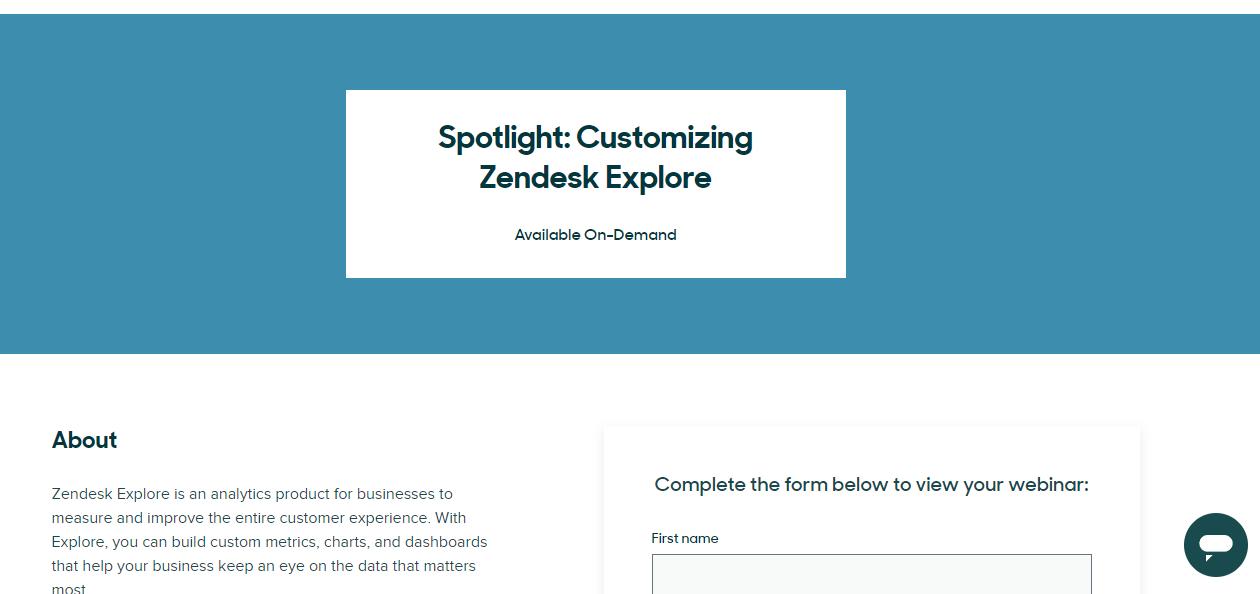
Zendesk earns bonus points for hosting a zoomed-in new feature webinar called Spotlight. While What’s New covers the newest feature releases, Spotlight dives into the features in greater detail for further illumination. Just as importantly, Spotlight dedicates time to foreshadow new features coming in the quarter to build anticipation and awareness around Zendesk’s future product updates.
Zendesk takes a democratized approach to webinar-ing. However, some companies may need to hyper-target their highest-value customers preemptively to avoid friction stemming from new feature adoption. Some customers use more, buy more, and stay longer than others, and losing these power users in the midst of a feature rollout could be devastating. Inviting these customers to “priority” webinars provides a way for your top clients to directly communicate questions or concerns—and for you to flip their anxieties into hype.
Zendesk’s adherence to regularly scheduled quarterly webinars addresses the format’s chief drawback: no one magically signs up for a webinar. Email invites must be sent. Social posts must be built to bring awareness to their existence. Using a dedicated landing page like Zendesk can boost organic and SEO traffic, but the success of feature-announcement webinars depends heavily upon dissemination across broader marketing channels.
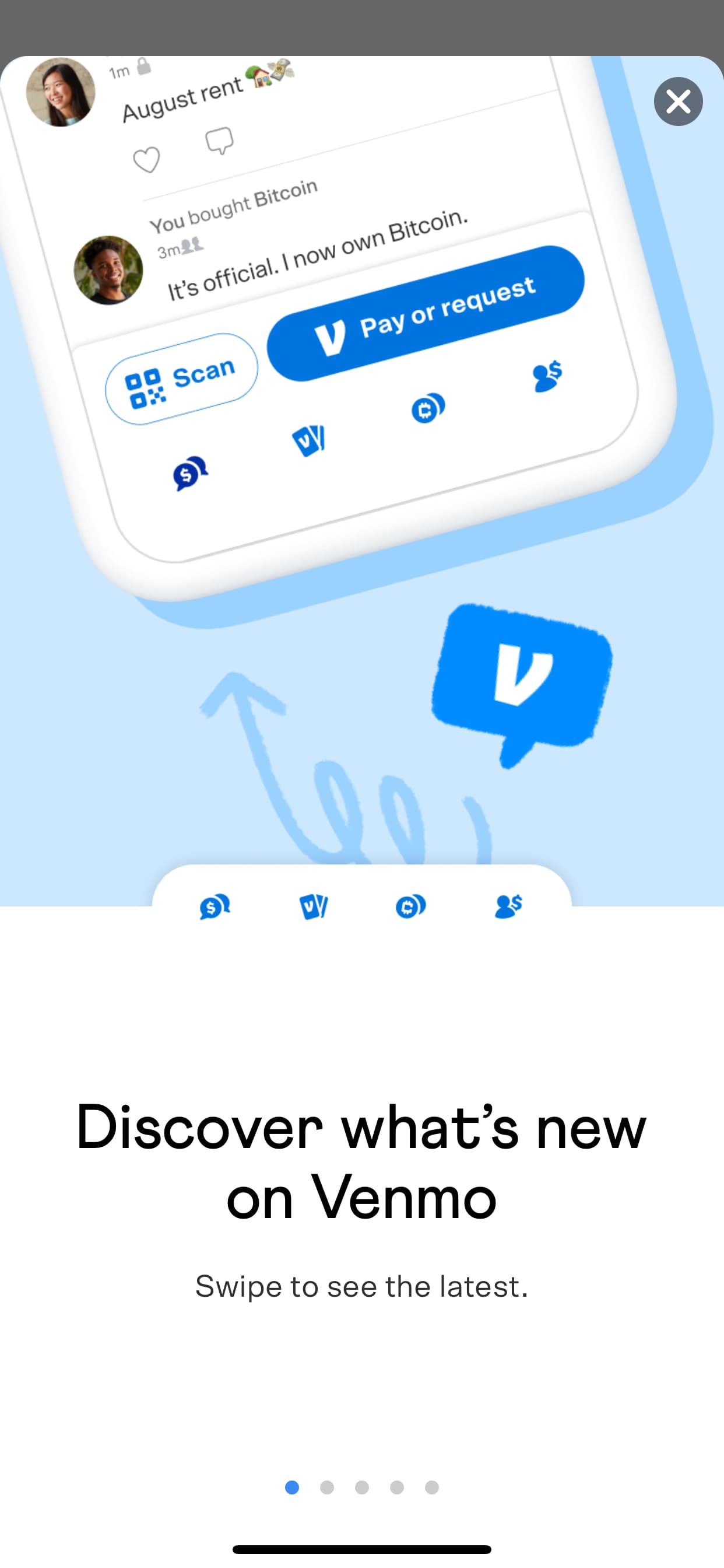
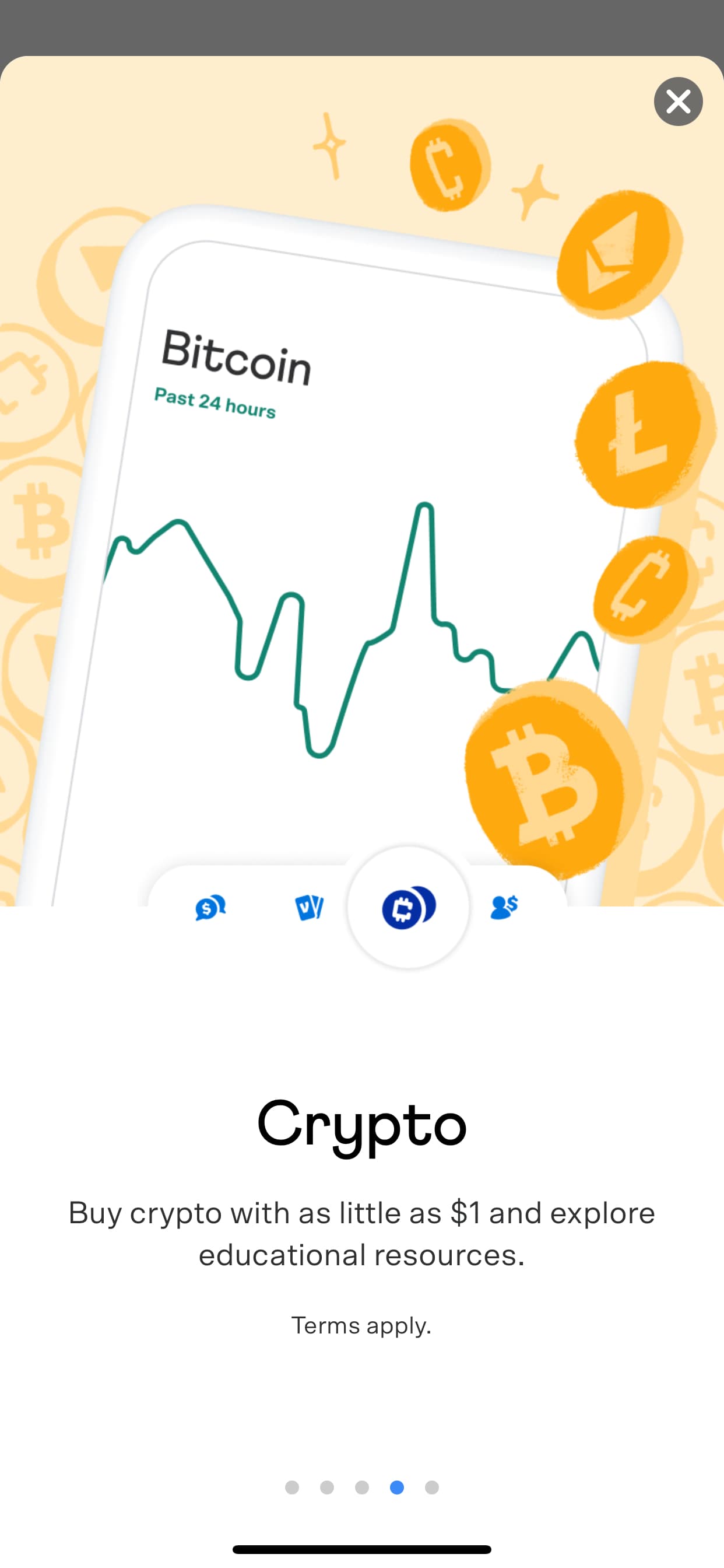
Did you know Venmo lets you buy and sell cryptocurrencies? Venmo customers surely do because the new feature was announced directly within its app.
In-app messaging is the king of addressing existing and active customers. Modals engage mobile and desktop customers as they’re using your product, kindly forcing them to acknowledge your newest features before returning to their regularly scheduled programming.
Venmo’s in-app messages are an excellent example of the delicate balance between relaying exciting new features and disrupting a customer’s experience. Its messages:
In-app messages can show interested users exactly where in an app the new features can be accessed to avoid confusion. This makes the format the perfect way to announce UI changes that might otherwise give regular users pause. Additionally, as in Venmo’s example, messages addressing a niche audience can be programmed as short, sweet, or even skippable. While social posts, blogs, landing pages, and webinars are better geared to target prospective users, in-app messaging has the corner on announcing new features to your active users.
After all the hard work and dedication you and your team have poured into developing those shiny new features, you deserve a rollout that's as smooth as a well-oiled machine. These crafty new feature announcements? They're not just noise—they're your megaphone to the world, stirring up excitement and smoothing over any user jitters. They're like a preemptive high-five to your customer service team, saving them from future headaches.
You've got the goods—those features are nothing short of spectacular. Now, it's about turning that excitement inward, getting your customers as jazzed about these updates as you are. It's showtime, and your features are ready to take center stage. Use your email marketing efforts to make a splash with your latest features and give customers a reason to connect your product with their use cases.
But wait, there's more! If you're hungry for even more wisdom on how to make your product's entrance a hit, dive into our guide how to write awesome product launch emails. It's packed with tips, tricks, and real-life examples to make your next product announcement email not just good, but great.
Ready to rev up your email game? Read More: How to write awesome product launch emails (+14 examples).